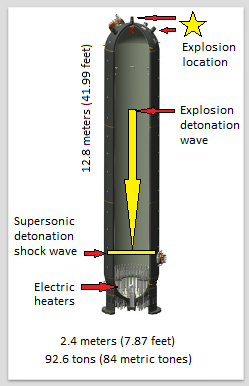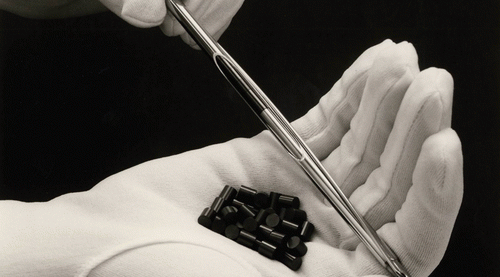Routine small explosions detonate all over the world at nuclear power plants. Ongoing research into the Ringhals 4 nuclear power plant damages concludes that small explosions detonated inside the nuclear reactor system, and this finding provides insights into the widespread detonation of explosions in nuclear power plants.
Originally, the question was asked "Did a Nuclear Power Plant Explosion Detonate in 2022 at Sweden's Ringhals 4 Nuclear Reactor?" (click here). That Op Ed provided a thread to peer-reviewed engineering journal papers, which explain the complexities of nuclear power plant explosions.
In that article, I questioned if there were explosions in 2015 that damaged nuclear fuel, and I further questioned if there was a 2022 explosion in the reactor pressurizer. Explosions probably did not, but may have detonated inside the pressurizer at the time of pressurizer heater damages.
More importantly, evidence presented here supports the conclusion that earlier blasts ignited inside the Ringhals 4 nuclear power plant to damage nuclear fuel, where Ringhals 4 is the cusp of myriad nuclear industry explosions.
Troubleshooting Nuclear Plant Explosions
Investigations of nuclear power plant explosions are complicated by the censorship of nuclear safety information by nuclear regulators and nuclear power plant operators. Having worked as a troubleshooter for industrial piping failures for decades, I know that troubleshooting is a difficult process.
One must work with limited information, and new discoveries are frequently required to determine why a failure occurred. As a troubleshooter, I have learned that engineers often and incorrectly blame manufacturing defects when a failure cause is unknown. Months or years may be needed to uncover new facts, and then more time is needed to mold those facts into a correct theory.
On occasion, one must invent new discoveries in physics. The Leishear Explosion Theory is one such new development in physics and engineering science.
Nuclear Power Plant Explosions
That is, in a series of peer reviewed engineering publications and supporting Op Eds, I have explained the fundamental explosion mechanisms in nuclear power plants. Initial detonations are of two types.
One type of detonation occurs after hydrogen and oxygen are formed when radioactivity breaks down water. If these gases are compressed at system high points, like the pressurizer in a pressurized water reactor, those gases heat due to compression and explode. I refer to this type of explosion as a water hammer explosion.
A second type of detonation occurs when water contacts a nuclear reactor core that is melting. Hydrogen and oxygen form in a process known as thermolysis, and an explosion ignites.
Such explosions started a series of explosions at both Fukushima Daiichi and Three Mile Island (TMI). Following reactor core explosions, water hammer explosions ignited explosions in reactor buildings, where building damages at TMI were negligible, and building explosions at Fukushima were catastrophic.
With respect to this Op Ed, I have published the conclusion that perhaps hundreds of small explosions detonate in nuclear plants. New research presented here connects nuclear reactor fuel rod damages to that conclusion.
Ringhals 4 Pressurizer Damages
When Vattenfall refused to answer a request for information, I assumed that they were covering up a pressurizer explosion during water additions to the reactor. A response from The Swedish Radiation Safety Authority proved that my assumption was incorrect.
'This is, in short, what actually happened in August 2022 at Ringhals 4: In the outage, just before restarting the reactor, different tests must be done to ensure that safety systems still [work as require]. The [yearly] test of the logic of the pressurizer is done to ensure that the power to actual heaters will be turned off in specified conditions. The test should be done before filling [the pressurizer] with water. The test, when done properly, should be done with isolated power to the heaters. By mistake, this was not the case this time, and when testing of the turn-off function, the actual heaters were warmed up and rather soon melted. The event has led to a production loss, but had no safety impact when it occurred.'
In other words, the nuclear reactor operator, Vattenfall, did not even know when essential safety equipment was turned on or not. No wonder that Vattenfall left this information out of their press release ("How Ringhals 4 is repaired", translated with Google Translate, click here).
Overheating of the pressurizer heaters was the primary cause for damages. However, if hydrogen and oxygen were present in the pressurizer, an explosion may have ignited. This opinion is presently theoretical, and the damages need further investigation to determine what really happened.
However, fuel damages from explosions are not theoretical. The Swedish Radiation Safety Authority further stated that:
'You had also a question about a fuel damage at Ringhals 4. A leaking fuel element, due to a hole or a crack in the cladding, is not a severe safety problem, but the permit holders will try to avoid them and prevent them, to keep radiation level as low as possible for the staff working in primary systems during next-coming outage for example. Fuel damages, or hole in the cladding due to debris, is more common in boiling waters reactors, where debris in the systems are more difficult to avoid. A common fuel damage starts with a small hole, caused by a debris that gets stucked in a spacer and fret a hole in the cladding. This brings a small leak of noble gases, that can be detected in chemical monitoring. This is called a primary damage. In some cases the damage stop there, but the cladding damage can also propagate to a secondary state, where the cladding on actual rod become brittle. This is what happened at Ringhals 4, when the rod cracked during investigation of the damage. The investigation was done to find a root cause for the actual damage. This is some facts from the report: During a shutdown made in February 2015, after a fuel leak was detected on 11-28-14, it was identified, that fuel cell had a damaged fuel rod. The visual inspection carried out in 2015 was then unable to provide any clear picture of the cause of damage. The fuel damage has been reported to the authorities. To investigate the damage, the fuel supplier had now started work with inspections and rod pulling in fuel elements in the fuel building. [Later], the leaking rod was found. When the rod was inspected, an indication of a possible crack could be discerned. The rod was rotated to check the size of the crack. The rod then broke off and a part falls down into position and the remaining part stays in the tool.'
My response was that:
'[L]et me talk about the fretting theory for fuel rod destruction. An assumption is made that a particle, or particles, becomes trapped next to the wall of the cladding, between the cladding and the spacer. Such a particle could carve a hole in the cladding wall. However, a mechanism to basically shatter the entire tube due to such a particle does not seem to be a reasonable conclusion.
Such a conclusion is like scratching your forehead, and expecting your skull to shatter. Such an analogy may seem absurd, but the fret and shatter theory is equally absurd.
On the other hand, reactor system explosions and fuel rod damages provide an explanation of fuel rod destruction. Shock waves can be generated in the pressurizer - or other system high points - during system pressure changes at any time during operations [Figure 1]. When radiolytically generated hydrogen and oxygen are compressed, the gases heat and explode. Shock waves from the explosion[s] travel throughout the reactor system and impact fuel rods and spacers. On impact, the stresses near the spacers will be much higher than stresses at other locations on the fuel rods, where the spacers act as stress raisers against the rods. Since this failure mechanism is related to fatigue failures, some locations will be more prone to failure than others. Note that fatigue stresses both crack and embrittle metals.
Seismic or accelerometer data at the plant during operations would prove these statements. Occasional pressure spikes would have occurred at the plant due to small explosions.' [High frequency pressure transducers can measure future hydrogen explosions in nuclear power plants].

Figure 1: Pressurizer explosions detonate shock waves throughout PWRs.
(Image by Adapted from Vattenfal) Details DMCA
A new study of nuclear power plant explosions is presented in Figure 2. Several conclusions are proved by these new calculations.
1) Residual hydrogen and oxygen at high points in a reactor system will explode during reactor restarts.
2) During normal operations, pressures in pressurized water reactor (PWR) pressurizers are within ~8.7% of the autoignition temperature of hydrogen, and pressure changes in pressurizers can therefore detonate hydrogen.
3) Pressures in boiling water reactor pressure (BWR) vessels are 35% lower than the hydrogen autoignition temperature, and detonation pressures are above the reactor shutdown pressure, or SCRAM pressure. Accordingly, BWR hydrogen explosions are not expected during normal operations, unless explosions are caused by water hammers.
4) Water hammers in the non-steam sections in BWR piping were observed at Hamaoka, Japan and Brunsbuettel, Germany nuclear power plants.
There are a great number of fuel damages that are not caused by hydrogen explosions in nuclear reactor systems ("Review of Fuel Failures in Water Cooled Reactors (2006-2015)", -pub.iaea.org/MTCD/Publications/PDF/PUB1864_web.pdf). Even so, PWR pressurizer explosions explain the fuel damages in the Ringhals 4 reactor, where those damages otherwise do not fit the facts. The impact of these findings with respect to other reactor designs needs further investigation (Figures 3 and 4).

Figure 3: Typical fuel rod and fuel pellets that are encased in the fuel rod.
(Image by OECD) Details DMCA
(Article changed on Feb 12, 2023 at 9:31 PM EST)






